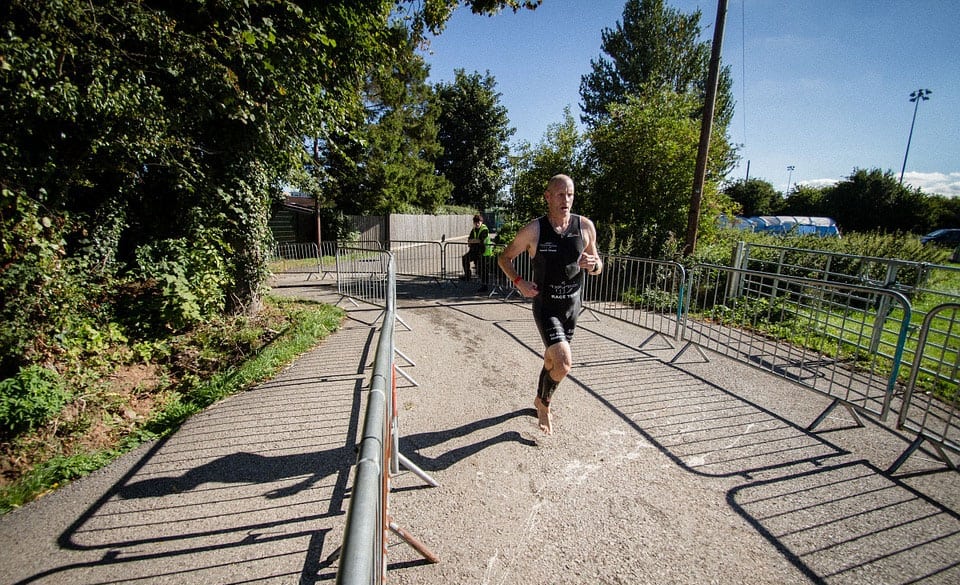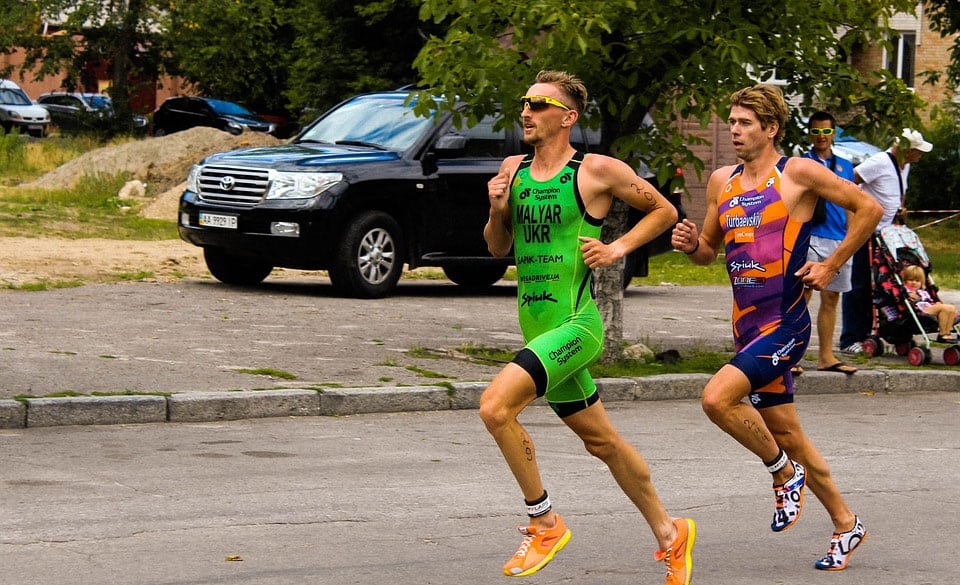
Training For A Triathlon Run Leg – UPDATED 2020 – How to Run Faster
Page Contents
Training for a triathlon run leg can be arguably the most difficult component of training for a triathlete. This is commonly where most injuries and performance issues arise. So why are most of us poor and inefficient runners, possibly due to a lack of practise? Realistically sitting at a desk for eight hours per day is not the best training for a triathlon run leg.
Training For The Triathlon Run Leg
When training for a triathlon run leg, it is very important to start conservatively. If you have not completed any running for an extended period, start by walking. This is very important, if you are not at your ideal weight.
Commencing with walking will ensure that you are getting your joints and tendons ready for the pounding involved in running. When you are ready, add some jogging in between walking for your training for a triathlon run leg. For example, run for five minutes and walk for three minutes and repeat on four occasions. You can change and modify the intervals for your training for a triathlon run leg pending you physical fitness. Keep building the distance, but NEVER increase by more than 15% per week. This will minimise your risk of injury and excessive fatigue and ensure that your body can cope with the gradual overload that you are placing upon it.
Gradually build up to running during you training for a triathlon run leg to three to four times a week, thirty to forty minutes. If you are an inexperienced runner do not clock up long distances initially. For examples 3 x 20 minute runs, will be far more beneficial than a 60 minute run leaving you hobbling around the home for week.
Moderation and frequency is the key whilst training for a triathlon run leg. You can add in a longer run once a week if you are training for the longer distances and once your fitness begins to progress. Ideally training for a triathlon run leg should consist a minimum of a three sessions (a) interval/speed session, (b) long/endurance run and (c) a short run off the bike, also called a brick session.
Triathlon Brick Sessions
Brick sessions form the cornerstone of making a smooth transition between the different disciplines. As there is no other training for a triathlon run leg that will prepare you for the sensation of cycling, jumping off the bike and running on what feels likes legs of jelly. The reason for this is that your legs have become accounted to travelling in small circles and when we commence running you are utilising additional muscle groups. You must practise training for a triathlon run leg to become accustomed to this sensation. This will provide the belief that this sensation is normally short lived and once you have trained for this aspect of the triathlon, it will be much easier to complete.
Triathlon Running Technique
Before we look at the triathlon training program for running, we need to have a look at some basics in regards to running techniques for you training for a triathlon run leg. There are a number of fantastic books on running techniques and ruining efficiency which are able to provide extensive detail and are far more exhaustive then what I have provide here. Although I just wanted to cover a few basic’s to assist with your running form. Here is some training for a triathlon run leg tips:
Look ahead, about ten to fifteen metres – Looking straight down at your feet will create a slouching posture. Whilst looking too far forward will cause you to lean back and slow down. So you need a balance.
Try to keep your torso upright – Think of being pulled upright like a puppet with a string through the head. This will prevent slouching and reduce excessive energy expenditure. If you start to feel that you are slouching, take a deep breath and this will assist to naturally straighten your posture whilst training for a triathlon run leg.
Keep your shoulders relaxed – Try to avoid lifting them up to your neck. You do not want to expend additional energy elevating your shoulders.
Keep your hands relaxed – with your fingers resting on your palms. When we fatigue or are experiencing discomfort from the run occasionally there can be a tendency to clench your fists whilst training for a triathlon run leg. So you need to concentrate on relaxing your hands.
Keep your arms relaxed and close to your body – It will reduce rotation of the torso and assist with breathing, by allowing the chest to remain open. Whilst running slide your arms forward and backwards, not across your body. When swinging the arms back whilst running, you want to keep an elbow angle of less than 90° whilst training for a triathlon run leg. This will assist the arms to be like a pendulum and produce a more efficient running style.
You should be striking the ground underneath your body – Not in front or behind. Striking the ground underneath your body reduces time the foot is in contact with the ground. It also reduces vertical movement of the body producing a more efficient and much faster running style whilst training for a triathlon run leg
Knees should be slightly flexed to bend upon impact with the ground – The knee should be situated straight over your second toe whilst landing. Bending the knee in the swing through the running gate (looks like kicking yourself in the butt) with assist to create speed on the run.
Try and keep your ankles flexed as you push off the ground – This will assist dispersing the load when contacting the ground whilst training for a triathlon run leg.
After reading that list I remember thinking, how do honestly make sure that I do all of those things and that my running technique is appropriate. You can get a friend to review your technique based on this list above or have someone videotape you via your phone. Then try and pick one to two techniques that you need to improve on. Focus on them until they become second nature during your training for a triathlon run leg. Then move onto other areas that require improvement. Focusing on multiple areas all at once will lead to frustration and delay your improvement.

How to Run Faster During A Triathlon
Once you have started to master your running technique and your fitness is improving. It is then time to consider how to run faster. Remember when you were in in the younger grades of school and prestige was based on your ability to run fast. I still laugh as my five year tells me about his friends and status appears to be still based on who can run the fastest. Even as adults we want to know how to run faster. To run faster we can either increase our cadence (running efficiency) or run with a longer stride (through forced based training activities). The African nations with their long distances athletes are a perfect example of this as they seem to run with very little effort. So let’s take a look at tips for raining for a triathlon run leg to run faster, including:
– If you want to run fast during a race, you will need to certainly run faster during training. So first and foremost you will need to practise running quickly through training.
– Count the amount of times that your foot comes in contact with the ground over one minute. This is commonly referred to as cadence. Most runners are likely to be approximately 75 to 85 foot strikes per minute. During your training for a triathlon run leg try and raise your cadence by two to three for a few minutes. It may feel awkward initially and results in an elevated heart rate, but this will improve with time.
– Performing stride drills. After warming up perform four to eight 30 second strides and then walk back to the starting point. It should be performed fast, but not flat out. I normally perform four sets of strikes with a thirty second jog, before performing my tempo or faster run for the week whilst training for a triathlon run leg.
My favourite and an underrated mode of transport is a skipping drill. When is the last time you skipped? Focus on skipping, initially for 40 skips, which will assist with an appropriate landing technique and build lower limb strength and flexibility. This will assist building power in your legs and increase stride length. If it is good enough for the Kenya runners it is good for us whilst training for a triathlon run leg.
Fartlek Running for Triathlon
Completing a variety of fartlek runs or tempo runs as provided in the example below. This will assist at becoming accustomed to running at a faster pace. As the easy running pace will start to feel that you travelling too slowly. Some examples of running sets may include
Fartlek Run #1
10 minute warm up and then 2x :
3 minute fast then 3 minute easy
90 sec fast then 90 sec easy
60 sec fast then 60 sec easy
45 sec fast then 45 sec easy
30 sec fast then 30 sec easy
10 minute cool down
Duration 50 minutes
Fartlek Run #2
10 minute warm up, then Run hard when you see a stop sign for 2 minutes and 2 minute recovery and repeat or Run hard to the next street light, jog to the next one and repeat.
10 minute cool down
Duration 50 minutes
When initially starting these types of runs you can walk during the rest phases as required. When your fitness improves, you can commence jogging during the easy sections.
There are an abundance of training sets of how to run faster and improve your running technique whilst training for a triathlon run leg. Remember not to increase your running loads by more than 15% per week to reduce the risk of injury. But most importantly remember to have fun. Running and training should not be a chore. Most of us complete triathlons for some form of enjoyment, do loose this aspect and don’t be too hard on yourself, as it will take some time to make changes whilst training for a triathlon run leg.



